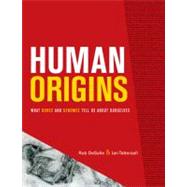Human Origins

Human Origins
- ISBN 13:
9781585445677
- ISBN 10:
1585445673
- Edition: 1st
- Format: Hardcover
- Copyright: 04/01/2008
- Publisher: Texas A & M Univ Pr
Rent
Sorry, this item is currently unavailable.
Note: Supplemental materials are not guaranteed with Rental or Used book purchases.
Extend or Purchase Your Rental at Any Time
Need to keep your rental past your due date? At any time before your due date you can extend or purchase your rental through your account.
Summary
Ever since the recognition of the Neanderthals as an archaic human in the mid-nineteenth century, the fossilized bones of extinct humans have been used by paleoanthropologists to explore human origins. These bones told the story of how the earliest humans--bipedal apes, actually--first emerged in Africa some 6 to 7 million years ago. Starting about 2 million years ago, the bones revealed, as humans became anatomically and behaviorally more modern, they swept out of Africa in waves into Asia, Europe and finally the New World. Even as paleoanthropologists continued to make important discoveries--Mary Leakey's Nutcracker Man in 1959, Don Johanson's Lucy in 1974, and most recently Martin Pickford's Millennium Man, to name just a few--experts in genetics were looking at the human species from a very different angle. In 1953 James Watson and Francis Crick first saw the double helix structure of DNA, the basic building block of all life. In the 1970s it was shown that humans share 98.7% of their genes with the great apes--that in fact genetically we are more closely related to chimpanzees than chimpanzees are to gorillas. And most recently the entire human genome has been mapped--we now know where each of the genes on the chromosomes that make up DNA is located on the double helix. InHuman Origins:What Bones and Genomes Tell Us about Ourselves, two of the world's foremost scientists, geneticist Rob DeSalle and paleoanthropologist Ian Tattersall, show how research into the human genome confirms what fossil bones have told us about human origins. This unprecedented integration of the fossil and genomic records provides the most complete understanding possible of humanity's place in nature, its emergence from the rest of the living world, and the evolutionary processes that have molded human populations to be what they are today. Human Originsserves as a companion volume to the American Museum of Natural History's new permanent exhibit, as well as standing alone as an accessible overview of recent insights into what it means to be human.






